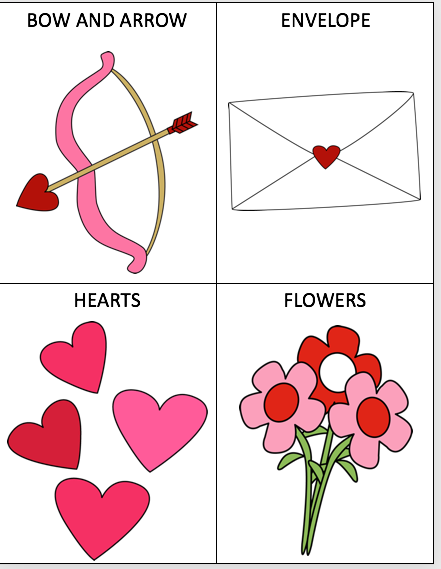Valentine’s Day Vocabulary Cards

Description
Large vocabulary cards to be used in matching games, go-fish, flash cards, etc.
Strategies and techniques
Directions and ideas:
--Print, cut and glue to construction paper (so the cards are not see-through), then laminate.
--Place in carrier phrases/sentence strips for sight word practice, expanding utterances and expressive ID of vocabulary
--Have children create their own sentences with the card and practice writing them.
--Use in receptive ID tasks or in matching 1:1 tasks for earlier language learners.
--Have the children come up with 3 adjectives or you describe and they locate the correct item
--Use as replacement cards in a game of Headbands
--Compare and contrast each item.
----Use as a matching game, sensory bins, vocabulary flash cards or as a Go-Fish game. (I usually do this as a reward after one of the above tasks have been completed.)
--Print, cut and glue to construction paper (so the cards are not see-through), then laminate.
--Place in carrier phrases/sentence strips for sight word practice, expanding utterances and expressive ID of vocabulary
--Have children create their own sentences with the card and practice writing them.
--Use in receptive ID tasks or in matching 1:1 tasks for earlier language learners.
--Have the children come up with 3 adjectives or you describe and they locate the correct item
--Use as replacement cards in a game of Headbands
--Compare and contrast each item.
----Use as a matching game, sensory bins, vocabulary flash cards or as a Go-Fish game. (I usually do this as a reward after one of the above tasks have been completed.)
License
Additional information
Resource details

Description
Large vocabulary cards to be used in matching games, go-fish, flash cards, etc.
Strategies and techniques
Directions and ideas:
--Print, cut and glue to construction paper (so the cards are not see-through), then laminate.
--Place in carrier phrases/sentence strips for sight word practice, expanding utterances and expressive ID of vocabulary
--Have children create their own sentences with the card and practice writing them.
--Use in receptive ID tasks or in matching 1:1 tasks for earlier language learners.
--Have the children come up with 3 adjectives or you describe and they locate the correct item
--Use as replacement cards in a game of Headbands
--Compare and contrast each item.
----Use as a matching game, sensory bins, vocabulary flash cards or as a Go-Fish game. (I usually do this as a reward after one of the above tasks have been completed.)
--Print, cut and glue to construction paper (so the cards are not see-through), then laminate.
--Place in carrier phrases/sentence strips for sight word practice, expanding utterances and expressive ID of vocabulary
--Have children create their own sentences with the card and practice writing them.
--Use in receptive ID tasks or in matching 1:1 tasks for earlier language learners.
--Have the children come up with 3 adjectives or you describe and they locate the correct item
--Use as replacement cards in a game of Headbands
--Compare and contrast each item.
----Use as a matching game, sensory bins, vocabulary flash cards or as a Go-Fish game. (I usually do this as a reward after one of the above tasks have been completed.)
License
Focus areas
- ST -> Expressive Language -> Answering Questions
- ST -> Expressive Language -> Asking Questions
- ST -> Expressive Language -> Attributes
- ST -> Expressive Language -> Differences
- ST -> Expressive Language -> Comparisons
- ST -> Expressive Language -> Labeling
- ST -> Expressive Language -> Reading
- ST -> Expressive Language -> Similarities
- ST -> Expressive Language -> Utterance Expansion
- ST -> Expressive Language -> Vocabulary
- ST -> Receptive Language -> Answering Questions
- ST -> Receptive Language -> Attributes
- ST -> Receptive Language -> Categories
- ST -> Receptive Language -> Differences
- ST -> Receptive Language -> Following Directions
- ST -> Receptive Language -> Labeling
- ST -> Receptive Language -> Pronouns
- ST -> Receptive Language -> Prepositions
- ST -> Receptive Language -> Reading
- ST -> Receptive Language -> Similarities
- ST -> Receptive Language -> Vocabulary
16 more focus areas. Click arrow to view all.
Evidence based practice citations
-
WH Question Comprehension and Students With Autism Spectrum Disorder
Author(s): Vicker, B. -
Adjective Learning In Young Typically Developing Children and Children With Developmental Language Disorder: A Retrieval-Based Approach
Author(s): Laurence B. Leonard, Patricia Deevy, Jeffrey D....
Grade levels
Grades PK - 5
Themes
Weekly Themes
None
Daily Themes
None
Blends
None
Phonemes
None
Resource slides
Create a free Ambiki account to preview the slides of this PDF resource.
